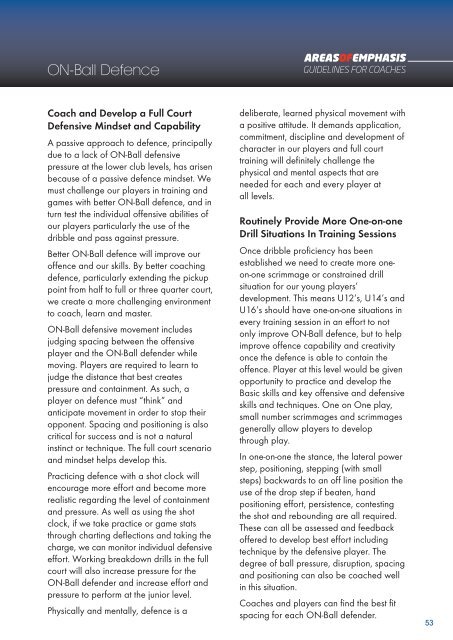You also want an ePaper? Increase the reach of your titles
YUMPU automatically turns print PDFs into web optimized ePapers that Google loves.
ON-Ball DefenceAREASOFEMPHASISGUIDELINES FOR COACHESCoach and Develop a Full CourtDefensive Mindset and CapabilityA passive approach to defence, principallydue to a lack of ON-Ball defensivepressure at the lower club levels, has arisenbecause of a passive defence mindset. Wemust challenge our players in training andgames with better ON-Ball defence, and inturn test the individual offensive abilities ofour players particularly the use of thedribble and pass against pressure.Better ON-Ball defence will improve ouroffence and our skills. By better coachingdefence, particularly extending the pickuppoint from half to full or three quarter court,we create a more challenging environmentto coach, learn and master.ON-Ball defensive movement includesjudging spacing between the offensiveplayer and the ON-Ball defender whilemoving. Players are required to learn tojudge the distance that best createspressure and containment. As such, aplayer on defence must “think” andanticipate movement in order to stop theiropponent. Spacing and positioning is alsocritical for success and is not a naturalinstinct or technique. The full court scenarioand mindset helps develop this.Practicing defence with a shot clock willencourage more effort and become morerealistic regarding the level of containmentand pressure. As well as using the shotclock, if we take practice or game statsthrough charting deflections and taking thecharge, we can monitor individual defensiveeffort. Working breakdown drills in the fullcourt will also increase pressure for theON-Ball defender and increase effort andpressure to perform at the junior level.Physically and mentally, defence is adeliberate, learned physical movement witha positive attitude. It demands application,commitment, discipline and development ofcharacter in our players and full courttraining will definitely challenge thephysical and mental aspects that areneeded for each and every player atall levels.Routinely Provide More One-on-oneDrill Situations In Training SessionsOnce dribble proficiency has beenestablished we need to create more oneon-onescrimmage or constrained drillsituation for our young players’development. This means U12’s, U14’s andU16’s should have one-on-one situations inevery training session in an effort to notonly improve ON-Ball defence, but to helpimprove offence capability and creativityonce the defence is able to contain theoffence. Player at this level would be givenopportunity to practice and develop theBasic skills and key offensive and defensiveskills and techniques. One on One play,small number scrimmages and scrimmagesgenerally allow players to developthrough play.In one-on-one the stance, the lateral powerstep, positioning, stepping (with smallsteps) backwards to an off line position theuse of the drop step if beaten, handpositioning effort, persistence, contestingthe shot and rebounding are all required.These can all be assessed and feedbackoffered to develop best effort includingtechnique by the defensive player. Thedegree of ball pressure, disruption, spacingand positioning can also be coached wellin this situation.Coaches and players can find the best fitspacing for each ON-Ball defender.53


